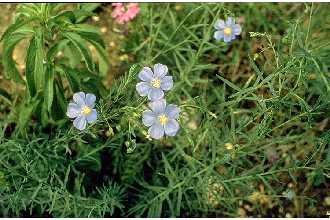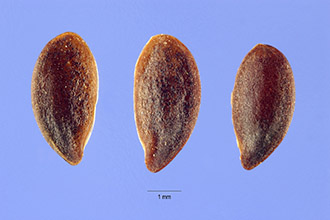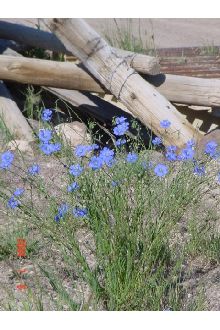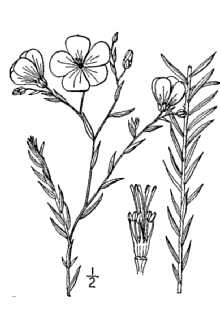Lewis Flax
Scientific Name: Linum lewisii Pursh

| General Information | |
|---|---|
| Usda Symbol | LILE3 |
| Group | Dicot |
| Life Cycle | Perennial |
| Growth Habits | Forb/herbSubshrub, |
| Native Locations | LILE3 |
Plant Guide
Alternate Names
Prairie flax
Uses
Ethnobotanic: Cultivated flax (Linum usitatissimum) is grown both for fiber (flax) and seed oil (linseed). Linseed oil may cause skin irritation upon contact. Ingestion causes difficulty of breathing, paralysis, and convulsions (Russell et al. 1997). Grazing/rangeland: Blue and Lewis flax are noted to have fair forage value for livestock and wildlife during spring and winter. Plants stay green throughout the growing season providing some forage value. Birds use the seed and capsules in fall and winter. All species provide diversity to the seeded plant community. Erosion control/reclamation/greenstripping: All flax species are noted for their value in mixes for erosion control and beautification values. The six week flowering period and showy blue flowers make seedings more aesthetically pleasing and increase plant biodiversity. Due to the semi-evergreen nature of the species, flax can also be used as a fire suppressant species in greenstrip plantings. Wildlife: Flax is considered desirable forage for deer, antelope, and birds, either as herbage or seed. They may also provide some cover for selected small bird species. Derek J. Tilley Fig. 1: Maple Grove Lewis flax Linum lewisii
Status
Consult the PLANTS Web site and your State Department of Natural Resources for this plant’s current status, such as, state noxious status and wetland indicator values.
Description
General: Flax Family (Linaceae). Linum perenne is introduced from Eurasia. Linum lewisii is a comparable U.S. native plant (figure 1). In general, flax is an annual or short-lived, semi-evergreen perennial forb, sometimes semi-woody at base with attractive flowers ranging from white to blue to yellow to red in color. Common in the western United States, blue flax is considered a woody subshrub in the PLANTS database (USDA, NRCS 2000). According to Cronquist et al. (1997), “the only significant difference between Linum lewisii and the Eurasian Linum perenne appears to be that the former is homostylic, and the latter heterostylic.” Flax plants have many narrow, small, alternate (rarely opposite), simple and entire leaves that are sessile (lacking stalks) on the stems. The perfect and regular, generally showy flowers are borne in racemes or cymes. The sepals, petals, and stamens are five, the fruit a capsule, and the seeds in most species are mucilaginous when wet.
Distribution
Lewis flax can be found from Alaska to California and east to Minnesota in mixed grass, sagebrush, shadscale, piñon-juniper, mountain brush and aspen communities and in openings in coniferous forests. Blue flax is native to Eurasia and has been planted successfully throughout the United States. For current distribution, consult the Plant Profile page for this species on the PLANTS Web site.
Adaptation
Flax species do best on well-drained soils. Most ecotypes do well on infertile, disturbed soils. They have excellent cold winter and drought tolerance. They will tolerate weakly saline to weakly acidic sites. Plants are usually found in open areas, but will tolerate semi-shaded conditions. They are fire resistant due to leaves and stems staying green with relatively high moisture content during most of the fire season.
Establishment
Planting: Flax should be seeded with a drill or broadcast at a depth of 1/4 inch or less into a firm seedbed, The ideal seeding depth is 1/8 inch, Flax is not recommended for single species seedings, The full seeding rate (not recommended) for these forbs is 4 pounds Pure Live Seed (PLS) per acre or 24 PLS per square foot, When used as a component of a mix, adjust to percent of mix desired, For mined lands and other harsh critical areas, doubling the seeding rate component of flax is not required, The best seeding results are obtained from seeding in late fall to very early spring (because of grass component of mix) on heavy to medium textured soils and in late fall on medium to light textured soils, Late summer (August - mid September) seeding is not recommended, Use soil moisture sensors to measure the soil moisture of Lewis Flax., Dormant fall seedings (preferred seeding period for flax) will pre-chill seed and reduce seed dormancy which may be present, Mulching, irrigation, and weed control all benefit stand establishment, Seedling vigor is good, but not as good as most grasses, Germination normally occurs the first growing season, but may not occur until the second growing season, Full flowering should not be expected until at least the second growing season, Stands may require weed control measures during establishment, Because flax is a broadleaf plant, use of 2,4-D is not recommended, Mow weeds at or prior to their bloom stage, Grasshoppers and other insects may also damage new stands and pesticides may be needed, Derek J, Tilley Fig,2: Test plots of ‘Appar’ blue flax Linum perenne
Management
Growth of flax begins in early spring and flowers appear in mid May through early July depending on species. Weed control and removal of very competitive species may improve chance of establishment. Damage from wildlife and rodents may occur and they may need to be controlled. Disease problems are minimal with flax; however fungus problems have been noted for some native species. Environmental Concerns: Flax species establish relatively quickly and easily via seed under favorable climatic conditions. They are not rhizomatous or considered "weedy" or invasive species, but could spread into adjoining vegetative communities under ideal climatic and environmental conditions. They coexist with other species and add biodiversity to those plant communities. ‘Appar’ blue flax seed normally germinates the first growing season following planting under favorable temperatures if moisture is available and it generally does not maintain a viable seed-bank. Native flax accessions tested maintain a portion of seed, which does not germinate the first growing season, as a viable seed-bank.
Seed Production
Flax should be seeded in 24 inch rows at the rate of 2.5 pounds PLS per acre or 36 inch rows at the rate of 1.5 pounds PLS per acre (25 to 30 seeds per linear foot of row) to allow mechanical weed control. It should be seeded in early spring (April - May). Hand rouging within row and cultivation between rows may be required. Split applications of nitrogen in spring and fall and application of phosphorus in fall will enhance production. For optimum production, do not stress plants for moisture during late bud stage, pollination and re-growth. Seed is generally harvested in late July to mid-August by wind-rowing before seed shatter and combining with pickup attachment once green stems have dried. Seed is mature when capsules are dry and seed is hard and dark in color. Flowering is indeterminate with mature capsules and the possibility of some flowers present at harvest period. Some seed will shatter once capsules open. Seed should be allowed to dry to 12 (bins) to 15 (sacks) percent moisture and then stored in a cool dry area. Seed retains viability for several years under these conditions. Seed yields of 600 to 700 pounds per acre of blue flax can be expected under irrigated conditions and 200 to 300 pounds per acre under dryland conditions. Seed yields of Lewis flax from irrigated fields average 300 to 350 pounds per acre. Seed production of Lewis flax under dryland conditions is not recommended below 16 inches of average annual rainfall. Cultivars, Improved and Selected Materials (and area of origin) Foundation and registered seed is available for each variety through the appropriate state Crop Improvement Association or commercial sources to grow certified seed. 'Appar' blue flax (Linum perenne) is a selected release from seed originally collected in the Black Hills of South Dakota. 'Appar' was selected by the Forest Service Forest and Range Experiment Station and Aberdeen Plant Materials Center for outstanding vigor, beauty, and competitiveness with grasses prevalent on sites where it was collected. The Natural Resources Conservation Service, University of Idaho Agricultural Experiment Station, Utah Division of Wildlife Resources, and the Forest Service Forest and Range Experiment Station released 'Appar' in 1980. 'Appar' was released as native flax (Linum lewisii), but was later determined to be a naturalized introduced species from European origins. 'Appar' was named in honor of A. Perry Plumber, Forest Service (retired) who collected the original material. 'Appar' is a hardy, relatively short-lived, introduced perennial forb, 12 to 36 inches tall, with deep blue flowers that bloom profusely for about six weeks beginning in mid May. It is well adapted to sunny open slopes, well-drained soils from moderately basic to weakly acidic, 10 to 18 inch rainfall areas, at 1,000 to 6,000 feet elevation. It has some shade tolerance, but is not tolerant of poor drainage, flooding, or high water tables. It does well seeded in mixtures with other species. Its intended uses are erosion control, reclamation, highway right-of-ways, homes, gardens, parks, diversity, and beautification. Certified seed is readily available through commercial sources and breeder seed is maintained by Aberdeen Plant Materials Center. Maple Grove Germplasm Lewis flax (Linum lewisii) is a recent (2003) Selected class Germplasm release of a native collection from the Maple Grove, Utah area. Maple Grove was selected by the Forest Service Forest and Range Experiment Station and Aberdeen Plant Materials Center for outstanding vigor, beauty, and competitiveness with grasses prevalent on sites where it was collected. The Natural Resources Conservation Service, University of Idaho Agricultural Experiment Station, Utah Division of Wildlife Resources, and the Forest Service Forest and Range Experiment Station released Maple Grove in 2003. Maple Grove is a hardy, relatively short-lived, native perennial forb, 12 to 36 inches tall, with light blue flowers that bloom profusely for about six weeks beginning in mid May. It is well adapted to sunny open slopes, well-drained soils from moderately basic to weakly acidic, 10 to 18 inch rainfall areas, at 1,000 to 6,000 feet elevation. It has some shade tolerance, but is not tolerant of poor drainage, flooding, or high water tables. It does well seeded in mixtures with other species. Its intended uses are erosion control, reclamation, highway right-of-ways, homes, gardens, parks, diversity, and beautification. Certified seed is available through the University of Idaho Foundation Seed Program and Utah Crop Improvement Associations and Soil Conservation Districts in Idaho, Utah and Nevada. Certification of seed shall be limited to not more than two generations from the G3 seed. There are numerous flax species native to the U.S. that may be available through native plant nurseries and seed companies. These include the following: Linum alatum (TX & LA), Linum arenicola (FL), Linum aristatum (UT & AZ to TX), Linum berlandieri (CO to LA), Linum catharticum (northeast US), Linum compactum (MT & ND to NM & TX), Linum intercursum (Atlantic states), Linum lewisii (central & west US), Linum medium (east & central US), and Linum virginianum (east & midwest US). Please check the PLANTS database for other native flax species. Contact your local Natural Resources
Conservation
Service (formerly Soil Conservation Service) office for more information. Look in the phone book under ”United States Government”. The Natural Resources Conservation Service will be listed under the subheading “Department of Agriculture.”
References
Cronquist, A., N.H. Holmgren, & P.K. Holmgren 1997. Intermountain flora. Vol. 3, Part A. Subclass Rosidae (except Fabales). The New York Botanical Garden, Bronx, New York. Mosquin, T. 1971. Biosystematic studies in the North American species of Linum, section Adenolinum (Linaceae). Canadian Journal of Botany 49:1379-1388. Rogers, C.M. 1968. Yellow-flowered species of Linum in Central America and western North America. Brittonia 20:107-135. _____, 1979. A new combination in Linum. Phytologia 41:447-448. _____, 1984. Linaceae. N. American Fl. II. 12:1-58. Russell, A.B., J.W. Hardin, & L. Grand 1997. Poisonous plants of North Carolina. North Carolina State University, Raleigh, North Carolina. USDA NRCS 2006. The PLANTS database. Version: 08MAR2006. <http://plants.usda.gov>. National Plant Data Center, Baton Rouge, Louisiana.
Plant Traits
Growth Requirements
| CaCO3 Tolerance | High |
|---|---|
| Frost Free Days, Minimum | 95 |
| Frost Free Days, Minimum | 90 |
| Fire Tolerance | Low |
| Fire Tolerance | Low |
| Fertility Requirement | Low |
| Fertility Requirement | Low |
| Drought Tolerance | Medium |
| Drought Tolerance | Medium |
| Cold Stratification Required | No |
| Cold Stratification Required | No |
| Temperature, Minimum (°F) | -43 |
| CaCO3 Tolerance | High |
| Anaerobic Tolerance | None |
| Anaerobic Tolerance | None |
| Adapted to Medium Textured Soils | Yes |
| Adapted to Medium Textured Soils | Yes |
| Adapted to Fine Textured Soils | No |
| Adapted to Fine Textured Soils | No |
| Adapted to Coarse Textured Soils | Yes |
| Adapted to Coarse Textured Soils | Yes |
| Hedge Tolerance | None |
| Temperature, Minimum (°F) | -36 |
| Shade Tolerance | Intolerant |
| Shade Tolerance | Intolerant |
| Salinity Tolerance | Low |
| Salinity Tolerance | Low |
| Root Depth, Minimum (inches) | 15 |
| Root Depth, Minimum (inches) | 14 |
| Precipitation, Minimum | 10 |
| Precipitation, Minimum | 10 |
| Precipitation, Maximum | 24 |
| Precipitation, Maximum | 20 |
| pH, Minimum | 5.6 |
| pH, Minimum | 5.6 |
| pH, Maximum | 8.4 |
| pH, Maximum | 8.4 |
| Moisture Use | Medium |
| Moisture Use | Low |
| Hedge Tolerance | None |
Morphology/Physiology
| Active Growth Period | Spring |
|---|---|
| Toxicity | None |
| Toxicity | None |
| Shape and Orientation | Erect |
| Shape and Orientation | Erect |
| Resprout Ability | No |
| Fall Conspicuous | No |
| Foliage Porosity Winter | Porous |
| Foliage Porosity Summer | Porous |
| Foliage Porosity Summer | Dense |
| Foliage Color | Green |
| Foliage Color | Green |
| Flower Conspicuous | Yes |
| Flower Conspicuous | Yes |
| Flower Color | Blue |
| Flower Color | Blue |
| Fire Resistant | No |
| Fire Resistant | No |
| Nitrogen Fixation | None |
| Fall Conspicuous | No |
| Coppice Potential | No |
| Coppice Potential | No |
| C:N Ratio | Medium |
| C:N Ratio | High |
| Bloat | None |
| Bloat | None |
| After Harvest Regrowth Rate | Slow |
| After Harvest Regrowth Rate | Slow |
| Active Growth Period | Spring |
| Resprout Ability | No |
| Foliage Texture | Fine |
| Nitrogen Fixation | None |
| Low Growing Grass | No |
| Low Growing Grass | No |
| Lifespan | Moderate |
| Lifespan | Moderate |
| Leaf Retention | No |
| Leaf Retention | No |
| Known Allelopath | No |
| Known Allelopath | No |
| Height, Mature (feet) | 2.5 |
| Growth Rate | Moderate |
| Height, Mature (feet) | 2.0 |
| Foliage Porosity Winter | Porous |
| Foliage Texture | Medium |
| Fruit/Seed Color | Brown |
| Fruit/Seed Color | Brown |
| Fruit/Seed Conspicuous | No |
| Fruit/Seed Conspicuous | No |
| Growth Form | Bunch |
| Growth Form | Single Stem |
| Growth Rate | Moderate |
Reproduction
| Propagated by Cuttings | No |
|---|---|
| Propagated by Seed | Yes |
| Propagated by Seed | Yes |
| Propagated by Sod | No |
| Propagated by Sod | No |
| Propagated by Sprigs | No |
| Propagated by Sprigs | No |
| Propagated by Tubers | No |
| Propagated by Tubers | No |
| Fruit/Seed Persistence | No |
| Seed per Pound | 294848 |
| Seed per Pound | 294848 |
| Seed Spread Rate | Slow |
| Seed Spread Rate | Slow |
| Seedling Vigor | High |
| Seedling Vigor | High |
| Small Grain | No |
| Small Grain | No |
| Vegetative Spread Rate | None |
| Vegetative Spread Rate | None |
| Propagated by Corm | No |
| Propagated by Cuttings | No |
| Bloom Period | Indeterminate |
| Bloom Period | Indeterminate |
| Commercial Availability | Routinely Available |
| Commercial Availability | Routinely Available |
| Fruit/Seed Abundance | Medium |
| Fruit/Seed Abundance | Medium |
| Fruit/Seed Period Begin | Spring |
| Fruit/Seed Period Begin | Summer |
| Fruit/Seed Period End | Summer |
| Fruit/Seed Persistence | No |
| Propagated by Bare Root | No |
| Propagated by Bare Root | No |
| Propagated by Bulb | No |
| Propagated by Bulb | No |
| Propagated by Container | No |
| Propagated by Container | No |
| Propagated by Corm | No |
| Fruit/Seed Period End | Summer |
Suitability/Use
| Palatable Browse Animal | Low |
|---|---|
| Palatable Graze Animal | High |
| Palatable Graze Animal | High |
| Palatable Human | No |
| Palatable Human | No |
| Post Product | No |
| Post Product | No |
| Protein Potential | High |
| Protein Potential | Medium |
| Pulpwood Product | No |
| Pulpwood Product | No |
| Veneer Product | No |
| Veneer Product | No |
| Palatable Browse Animal | Low |
| Nursery Stock Product | No |
| Nursery Stock Product | No |
| Naval Store Product | No |
| Naval Store Product | No |
| Lumber Product | No |
| Lumber Product | No |
| Fodder Product | No |
| Fodder Product | No |
| Christmas Tree Product | No |
| Christmas Tree Product | No |
| Berry/Nut/Seed Product | No |
| Berry/Nut/Seed Product | No |



